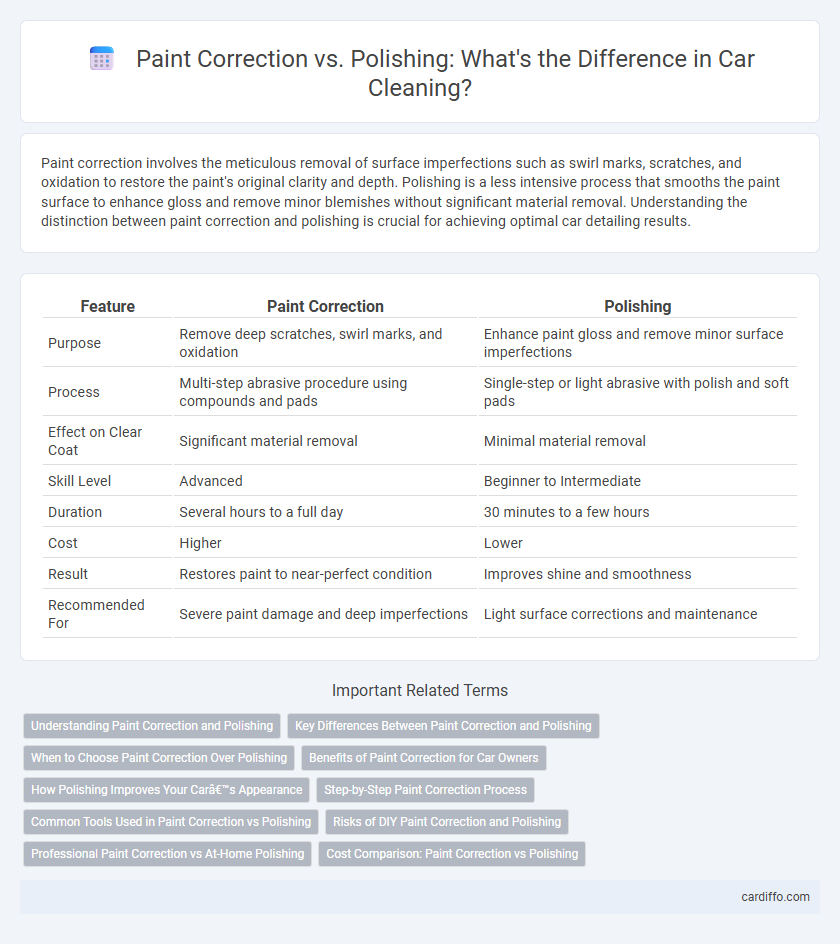Paint correction involves the meticulous removal of surface imperfections such as swirl marks, scratches, and oxidation to restore the paint's original clarity and depth. Polishing is a less intensive process that smooths the paint surface to enhance gloss and remove minor blemishes without significant material removal. Understanding the distinction between paint correction and polishing is crucial for achieving optimal car detailing results.
Table of Comparison
| Feature | Paint Correction | Polishing |
|---|---|---|
| Purpose | Remove deep scratches, swirl marks, and oxidation | Enhance paint gloss and remove minor surface imperfections |
| Process | Multi-step abrasive procedure using compounds and pads | Single-step or light abrasive with polish and soft pads |
| Effect on Clear Coat | Significant material removal | Minimal material removal |
| Skill Level | Advanced | Beginner to Intermediate |
| Duration | Several hours to a full day | 30 minutes to a few hours |
| Cost | Higher | Lower |
| Result | Restores paint to near-perfect condition | Improves shine and smoothness |
| Recommended For | Severe paint damage and deep imperfections | Light surface corrections and maintenance |
Understanding Paint Correction and Polishing
Paint correction involves removing surface imperfections such as scratches, swirl marks, and oxidation by using abrasive compounds to restore the vehicle's clear coat to its original condition. Polishing, on the other hand, is a less aggressive process aimed at enhancing the paint's gloss and smoothness by eliminating minor imperfections and refining the surface. Understanding the difference between paint correction and polishing helps determine the appropriate level of care needed for maintaining a vehicle's exterior finish.
Key Differences Between Paint Correction and Polishing
Paint correction involves the detailed process of removing surface imperfections such as swirl marks, scratches, and oxidation to restore the vehicle's paint to a flawless condition. Polishing is a less intensive step aimed at enhancing the paint's gloss and smoothness by lightly abrading minor flaws without significant paint layer removal. Key differences include the depth of paint defect removal, with paint correction correcting more severe damage and polishing providing a final finish to improve shine and clarity.
When to Choose Paint Correction Over Polishing
Paint correction is ideal when deep scratches, swirl marks, or oxidation have compromised the vehicle's clear coat, requiring a more aggressive approach to restore paint clarity. Polishing suits minor imperfections like light scratches and surface contaminants, enhancing gloss without significant material removal. Choose paint correction over polishing when the paint surface demands extensive leveling and defect removal for a flawless finish.
Benefits of Paint Correction for Car Owners
Paint correction effectively removes surface imperfections such as swirl marks, oxidation, and scratches, restoring the vehicle's original shine and color depth. This process enhances the car's resale value by maintaining a pristine exterior condition and protecting the paint from environmental damage. Regular paint correction also extends the lifespan of the clear coat, reducing the need for costly repainting or touch-ups.
How Polishing Improves Your Car’s Appearance
Polishing removes surface imperfections such as light scratches, oxidation, and swirl marks, restoring the paint's clarity and depth. It smooths the clear coat, enhancing gloss and creating a mirror-like finish that significantly improves the car's overall appearance. Regular polishing not only revitalizes paintwork but also prepares the surface for effective waxing, extending the protection and shine.
Step-by-Step Paint Correction Process
The step-by-step paint correction process begins with a thorough wash and clay bar treatment to remove surface contaminants, ensuring a clean base. Next, a detailed inspection helps identify paint defects such as swirl marks, scratches, and oxidation, guiding the choice of appropriate polishing compounds and machines. The final steps involve machine polishing with progressively finer pads and polishes to restore the paint's clarity and depth, followed by a protective sealant or wax application to preserve the finish.
Common Tools Used in Paint Correction vs Polishing
Paint correction commonly uses dual-action polishers, microfiber cutting pads, and abrasive compounds to remove surface imperfections and restore paint clarity. Polishing typically involves less aggressive tools such as foam polishing pads, rotary buffers, and fine polishing agents to enhance shine and smoothness without significant paint removal. Both processes rely heavily on quality abrasives and machines tailored to the specific level of paint surface refinement required.
Risks of DIY Paint Correction and Polishing
DIY paint correction and polishing carry significant risks, including the potential for uneven surface damage and swirl marks due to lack of professional technique and equipment. Inexperienced handling of abrasive compounds can result in clear coat thinning or removal, leading to expensive paint repairs. Proper training and tools are critical to avoid permanent damage and maintain the vehicle's aesthetic value.
Professional Paint Correction vs At-Home Polishing
Professional paint correction involves advanced techniques and specialized tools to remove deep scratches, oxidation, and swirl marks, restoring a vehicle's paint to near-showroom quality. At-home polishing typically uses less abrasive compounds and basic equipment to enhance shine and remove minor imperfections but cannot achieve the same level of surface restoration as professional services. Investing in professional paint correction ensures comprehensive surface refinement and long-lasting results that at-home polishing cannot match.
Cost Comparison: Paint Correction vs Polishing
Paint correction typically involves more labor-intensive processes and specialized equipment, resulting in higher costs compared to polishing. Polishing is a less expensive technique aimed at minor surface imperfections, often priced at a fraction of paint correction services. Customers seeking significant surface restoration should expect paint correction prices to be two to three times higher than standard polishing treatments.
Paint correction vs Polishing Infographic

 cardiffo.com
cardiffo.com